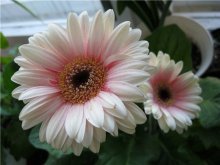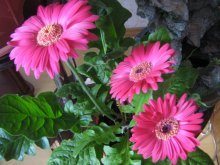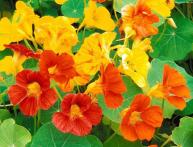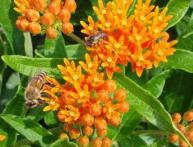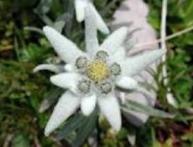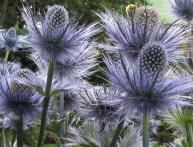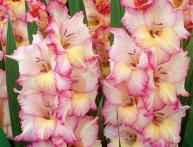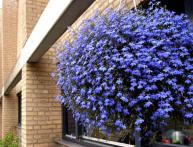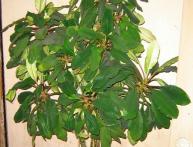Secrets of proper care of gerbera in pots
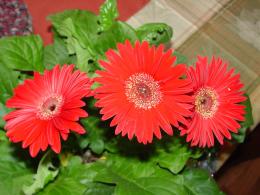
Growing indoor plants in the age of rapid development of information technology and increased psycho-emotional stress is one of the ways of emotional satisfaction, relaxation, seeking harmony and creating comfort in the home. The bright colors of gerberas always attract attention; they resemble large multi-colored daisies, which can not only lift your spirits, but also become a real decoration for any interior.
Content:
- Description and varietal diversity
- Planting, propagation and replanting of gerberas
- Proper plant care
Description and varietal diversity
Gerbera is an amazing flower with a fairly wide range of colors. An ancient legend says that a forest nymph named Gerba turned into a modest gerbera flower. She was very beautiful, people around her constantly admired her.
Tired of such close attention to her person, she decided to become an inconspicuous flower. However, the gerbera is impossible to miss. Terry petals always attract attention. It is characterized by increased resistance to frost and drafts, easily takes root when transplanted, and is considered a rather unpretentious plant. Therefore, many people love to grow gerbera at home, in flower pots.
There are several varieties of indoor gerberas:
- Gerber Jameson. It is the most common plant. It is customary to grow the dwarf decorative species of Jameson's gerbera in pots.This variety is quite hardy, distinguished by large multi-colored flowers and wide leaves.
- Festival. A variety that is ideal for growing in pots. The plant's large flowers are combined with fairly compact leaf sizes.
- Viola. The variety is characterized by narrow leaves and large double flowers.
- Two-color gerberas. They are especially popular due to the unusualness of their colors.
You can list a huge number of varieties gerberas, each of them has its own distinctive characteristics. Breeders are constantly working to develop new varieties that are even more refined, beautiful and adapted to home conditions.
Planting, propagation and replanting of gerberas
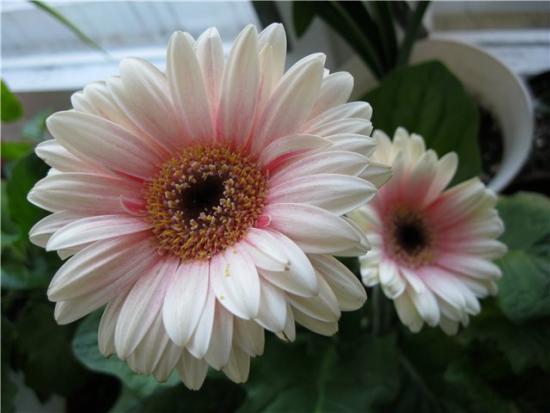
In order to preserve the plant, several rules must be followed. Every year, the gerbera requires transplanting into a larger pot, replacing the soil and drainage. It is best to choose fertile soil, rich in vitamins and minerals, or buy ready-made soil at any flower shop. Before planting, the soil must be heated, watered and only then planted.
Gerbera is a heat-loving plant; if planted in frozen ground, it may die. When replanting, you should carefully monitor the rosette of leaves; it should not be covered too deeply with soil; the leaves should be protected from soil getting on them.
In order to engage in self-reproduction gerberas, you should know that there are 2 main methods of propagation - dividing adult plants and growing young plants from seeds.
Seeds are sown in warm, moist soil in pots or boxes in early spring. When the seedlings grow and 3 leaves appear on them, you can pick.After 5-6 leaves appear, the plants can be transplanted into separate pots. After about a month, young gerberas can be fed to enhance their growth.
The most preferred method of propagating gerberas, in which one plant inherits all the characteristics of another, is division. An adult plant 4-5 years old is selected for division. The most favorable period is considered to be early spring. An adult plant is carefully divided along the rhizome into one or two separate plants, which are planted in pots. Their planting and care are identical to the basic rules for replanting and caring for adult plants.
Proper plant care
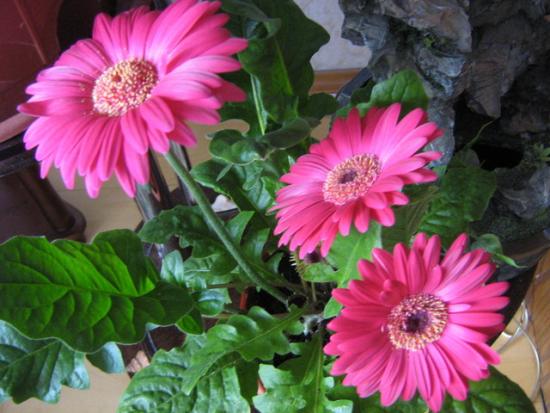
In order to grow healthy beautiful plant Several rules must be followed:
- Timely watering and moistening. It is necessary to water the gerbera only with warm water, at room temperature, not boiled. Watering is carried out evenly throughout the year. Moisturizing the leaves by spraying should be done as often as possible; gerbera loves moisture.
- Correct lighting. Like no other plant, gerbera loves direct sunlight. Therefore, growing it on a windowsill is most preferable.
- Feeding. It is recommended to feed gerbera 2-3 times a month with mineral fertilizers. This rule mainly applies to young or recently transplanted plants. But even an adult gerbera needs mineral feeding 1-2 times a year. After all, it is fertilizers that allow it to grow faster, bloom luxuriantly and protect it from diseases.
- Removing dried stems. The plant must be promptly removed from dried or rotten stems, leaves and flowers. Gerberas are usually not pruned.
- Pest protection. Gerbera is susceptible to powdery mildew, as well as harmful insects - aphids, scale insects. In order to protect it from pests and diseases, a phytosporin solution is used. The plant is sprayed with it, and infected or damaged areas are removed.
Thus, we can conclude that gerbera is not a capricious plant, it does not require careful care and special attention, it grows well in pots and is a very beautiful indoor plant. By following simple rules of care, you can enjoy the modest beauty and aroma of gerbera in your home throughout the year.
Features of growing gerbera in the video:
Interesting information about the vegetable garden

